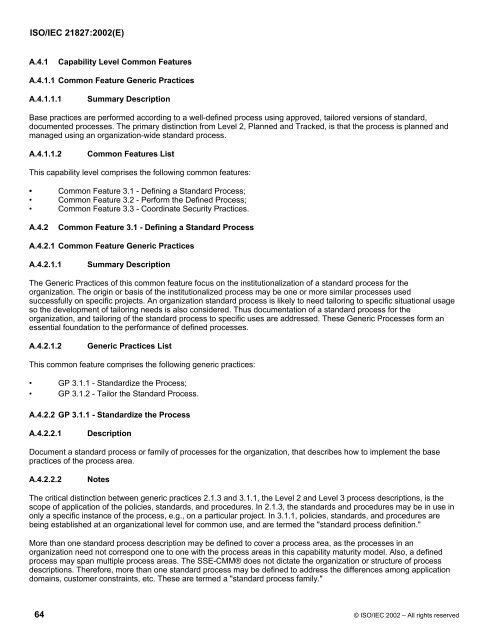ISO/IEC 21827
ISO/IEC 21827
ISO/IEC 21827
Create successful ePaper yourself
Turn your PDF publications into a flip-book with our unique Google optimized e-Paper software.
<strong>ISO</strong>/<strong>IEC</strong> <strong>21827</strong>:2002(E)<br />
A.4.1<br />
Capability Level Common Features<br />
A.4.1.1 Common Feature Generic Practices<br />
A.4.1.1.1<br />
Summary Description<br />
Base practices are performed according to a well-defined process using approved, tailored versions of standard,<br />
documented processes. The primary distinction from Level 2, Planned and Tracked, is that the process is planned and<br />
managed using an organization-wide standard process.<br />
A.4.1.1.2<br />
Common Features List<br />
This capability level comprises the following common features:<br />
• Common Feature 3.1 - Defining a Standard Process;<br />
• Common Feature 3.2 - Perform the Defined Process;<br />
• Common Feature 3.3 - Coordinate Security Practices.<br />
A.4.2<br />
Common Feature 3.1 - Defining a Standard Process<br />
A.4.2.1 Common Feature Generic Practices<br />
A.4.2.1.1<br />
Summary Description<br />
The Generic Practices of this common feature focus on the institutionalization of a standard process for the<br />
organization. The origin or basis of the institutionalized process may be one or more similar processes used<br />
successfully on specific projects. An organization standard process is likely to need tailoring to specific situational usage<br />
so the development of tailoring needs is also considered. Thus documentation of a standard process for the<br />
organization, and tailoring of the standard process to specific uses are addressed. These Generic Processes form an<br />
essential foundation to the performance of defined processes.<br />
A.4.2.1.2<br />
Generic Practices List<br />
This common feature comprises the following generic practices:<br />
• GP 3.1.1 - Standardize the Process;<br />
• GP 3.1.2 - Tailor the Standard Process.<br />
A.4.2.2 GP 3.1.1 - Standardize the Process<br />
A.4.2.2.1<br />
Description<br />
Document a standard process or family of processes for the organization, that describes how to implement the base<br />
practices of the process area.<br />
A.4.2.2.2<br />
Notes<br />
The critical distinction between generic practices 2.1.3 and 3.1.1, the Level 2 and Level 3 process descriptions, is the<br />
scope of application of the policies, standards, and procedures. In 2.1.3, the standards and procedures may be in use in<br />
only a specific instance of the process, e.g., on a particular project. In 3.1.1, policies, standards, and procedures are<br />
being established at an organizational level for common use, and are termed the "standard process definition."<br />
More than one standard process description may be defined to cover a process area, as the processes in an<br />
organization need not correspond one to one with the process areas in this capability maturity model. Also, a defined<br />
process may span multiple process areas. The SSE-CMM® does not dictate the organization or structure of process<br />
descriptions. Therefore, more than one standard process may be defined to address the differences among application<br />
domains, customer constraints, etc. These are termed a "standard process family."<br />
64 © <strong>ISO</strong>/<strong>IEC</strong> 2002 – All rights reserved
















